| Karkee Web Home Page | Japanese Pattern Home Page |
Japanese Pattern Equipment -
Component Data and Illustrations
Known photographs of the Japanese Pattern Equipment in use with U.K. troops are confined to just one photo, in the K.O.S.B. Museum archives, which we are therefore unable to reproduce. This lack of photographic evidence suggests that the service period might have been very short. This one photo shows neither a Haversack, nor a Water bottle. If these were worn during training, they were quite likely to be obsolete / obsolescent Victorian versions, such were the shortages of accoutrements. Many troops also wore a mixture of Valise Equipment, Patterns 1882 and 1888, which we intend to cover in future uploads.
Belt, waist, without runners, lengthened
In appearance, this was much like a Bandolier Equipment Waist belt, but the brass buckle frame is of a much thinner cross-section, probably drawn wire, as opposed to the blanked B.E. buckle. Where the latter was convex, the J version was concave, the side frames not aligning with the tongue bar. The buckle was stitched into place, unlike the B.E. Belt. A Runner, leather, waistbelt was also fitted, which is much broader than the U.K. norm. The nomenclature suggests that all such Belts were lengthened with an insert, as in this example. This is thought to be because the Japanese were of slighter physique. From the Oliver Lock Collection. Photographs © Oliver Lock, 2014.
Frogs, bayonet, Japanese Pattern Equipment. (Speculative designation)


 While no official documentation or photograph evidence has come to light indicating that Frogs, bayonet were included in the British acquisition of Japanese equipment, it is however, logical to assume that at least some Frogs were acquired given that both the Belts and Bayonets were. Anthony Carter, in his book, Bayonet Belt Frogs, lends some support to this theory with illustration 140, which shows a Japanese type Frog, which has been modified by the addition of a helve holder strap, the Carrier, intrenching tool, helve being a piece of equipment peculiar to Britain.
While no official documentation or photograph evidence has come to light indicating that Frogs, bayonet were included in the British acquisition of Japanese equipment, it is however, logical to assume that at least some Frogs were acquired given that both the Belts and Bayonets were. Anthony Carter, in his book, Bayonet Belt Frogs, lends some support to this theory with illustration 140, which shows a Japanese type Frog, which has been modified by the addition of a helve holder strap, the Carrier, intrenching tool, helve being a piece of equipment peculiar to Britain.
The illustrated example is a representative Japanese Frog, which, along with its bayonet, was sourced from Finland by the current owner. Given its providence, it may well have been among the ex-Japanese equipment disposed of to the Russians in 1916, or part of the military aid provided by Britain post Great War to some Baltic Countries. Unmarked and of stitched leather construction, 20 cm long by 6.75 cm wide, the Scabbard, sword-bayonet, .256 inch rifle was secured in the Frog by a 12 mm tab which fed up through a loop on the scabbard, then back over the loop and down to a buckle on the Frog. The last photo shows the Frog fitted to the Scabbard, sword-bayonet, .256 inch rifle. From the Grant Napier collection. Photographs © Graham Tweeddale 2013.
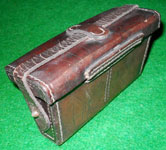
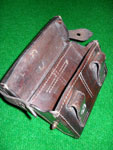
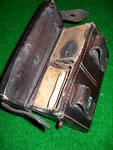
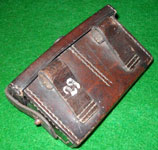 This was hinged on its front face, the lid formed into a box lid with stitched-in side pieces. A fixed loop was stitched centrally on the lid, through which passed a narrow strap. This secured the lid when attached at each end to studs mounted half-way up the pouch sides.
This was hinged on its front face, the lid formed into a box lid with stitched-in side pieces. A fixed loop was stitched centrally on the lid, through which passed a narrow strap. This secured the lid when attached at each end to studs mounted half-way up the pouch sides.
The Pouch had front and rear walls in one piece, with inverted, trapezoidal sides box-stitched into place. A centre partition divided the Pouch to accommodate three clips of five cartridges in each compartment. In one of the open shots, you can see cartridge packets in place.
A pair of belt loops on the rear were stitched at the top, turned over to give a half-proud loop and stitched flat at the bottom. A set comprised two of these Pouches. Given the nomenclatures of Patt. ’14 Infantry Equipment, a better choice might perhaps have been Pouch, ammunition, 30 rounds, J. It is noteworthy that neither front, nor rear Pouches have metal loops for Braces to be attached. From the Alfred Kruk Collection. Photographs © Alfred Kruk, 2013.
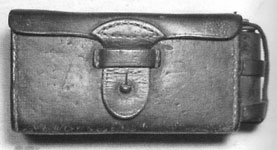
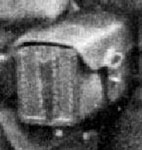
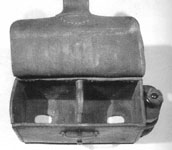 The nomenclature here is ascribed, based on the other Pouches being “small”. The Japanese issue had one of these Pouches, placed in the small of the back and constituting a “magazine pouch”. In other words, it contained the reserve ammunition supply. B&W photos are from Alfred Kruk’s book, Patronentaschen, Patronengurtel und Banduliere, 1850 – 1950.
The nomenclature here is ascribed, based on the other Pouches being “small”. The Japanese issue had one of these Pouches, placed in the small of the back and constituting a “magazine pouch”. In other words, it contained the reserve ammunition supply. B&W photos are from Alfred Kruk’s book, Patronentaschen, Patronengurtel und Banduliere, 1850 – 1950.
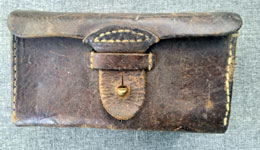
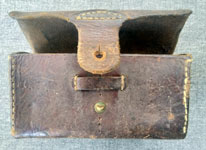
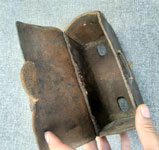 Unlike the front Pouches, this was a straightforward box Pouch, formed from a one-piece front and back, with sides box-stitched in place to form a rectangular cross-section. A simple flap was stitched on the rear, above the belt loops. A stylised tab was stitched to the edge of the flap, which fastened, through a fixed leather loop, to a stud just below.
Unlike the front Pouches, this was a straightforward box Pouch, formed from a one-piece front and back, with sides box-stitched in place to form a rectangular cross-section. A simple flap was stitched on the rear, above the belt loops. A stylised tab was stitched to the edge of the flap, which fastened, through a fixed leather loop, to a stud just below.
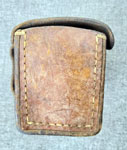
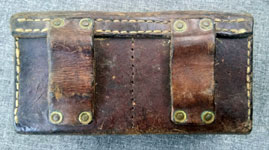
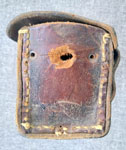 Internally, it was divided into left and right compartments, each of which held two packets of 15 rounds, making 60 rounds in all. In the base of each compartment there was an elongated, thumb hole, so that packets could be pushed out. Viewed from the front, two small loops were stitched to the side of the Pouch. A short, button-holed strap was stitched underneath the lower loop and two the centre of each loop. The oil bottle had a pillar stud on its stopper and the strap fastened over this. As can be see, the example in the modern photos has had both the internal divider and the strap for the oil bottle removed.
Internally, it was divided into left and right compartments, each of which held two packets of 15 rounds, making 60 rounds in all. In the base of each compartment there was an elongated, thumb hole, so that packets could be pushed out. Viewed from the front, two small loops were stitched to the side of the Pouch. A short, button-holed strap was stitched underneath the lower loop and two the centre of each loop. The oil bottle had a pillar stud on its stopper and the strap fastened over this. As can be see, the example in the modern photos has had both the internal divider and the strap for the oil bottle removed.
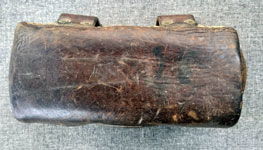
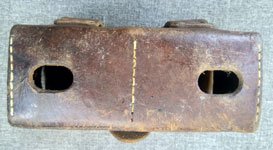 As with the “small”, a better nomenclature would have been Pouch, ammunition, 60 rounds, J, although the single letter J seems insufficiently prominent to distinguish these from the Patt. ’14 nomenclature – had they even been listed! In addition to the two types of Pouch, the K.O.S.B. photo referred to above, shows a 50 round Patt. ’03 Bandolier, giving 140 rounds in all. The colour photos were taken from a listing in the New Zealand website trademe, are here reproduced without permission. If the owner of this pouch will get in touch with us, we will be happy to give him (or her) proper recognition and copyright acknowledgement.
As with the “small”, a better nomenclature would have been Pouch, ammunition, 60 rounds, J, although the single letter J seems insufficiently prominent to distinguish these from the Patt. ’14 nomenclature – had they even been listed! In addition to the two types of Pouch, the K.O.S.B. photo referred to above, shows a 50 round Patt. ’03 Bandolier, giving 140 rounds in all. The colour photos were taken from a listing in the New Zealand website trademe, are here reproduced without permission. If the owner of this pouch will get in touch with us, we will be happy to give him (or her) proper recognition and copyright acknowledgement.
 No example has been handled, but it loosely follows the Royal Navy form and is assumed to be of Japanese manufacture. The butt end is fixed to the swivel with a loose Stud, brass, sling, rifle. The upper end was furnished with a “Single Buckle”, specifically Buckle, brass, sling, rifle, with a Runner, leather, sling, rifle to retain the doubled portion of the Sling. To assemble, the running end was passed through the upper swivel, from inside to outside, then threaded through the buckle. The running end could then be double through the butt swivel and secured with the stud.
No example has been handled, but it loosely follows the Royal Navy form and is assumed to be of Japanese manufacture. The butt end is fixed to the swivel with a loose Stud, brass, sling, rifle. The upper end was furnished with a “Single Buckle”, specifically Buckle, brass, sling, rifle, with a Runner, leather, sling, rifle to retain the doubled portion of the Sling. To assemble, the running end was passed through the upper swivel, from inside to outside, then threaded through the buckle. The running end could then be double through the butt swivel and secured with the stud.
 The photograph at left is from the 1904 catalogue produced by the Mills Woven Cartridge Belt Company (U.K.). It shows Japanese troops sorting packets of Arisaka rounds during the Russo-Japanese War (1904-5) – the war where Russian warships fired on British trawlers, killing three fishermen. They had mistaken these small ships for Japanese warships – in the North Sea!!! Mills used the photo to illustrate the difficulties of ammunition supply, extolling the virtues of their 100 round Emergency Bandoliers, the forerunner of the Bandolier, cotton, 50 rounds. It is additionally interesting for showing no Braces supporting the Belt.
The photograph at left is from the 1904 catalogue produced by the Mills Woven Cartridge Belt Company (U.K.). It shows Japanese troops sorting packets of Arisaka rounds during the Russo-Japanese War (1904-5) – the war where Russian warships fired on British trawlers, killing three fishermen. They had mistaken these small ships for Japanese warships – in the North Sea!!! Mills used the photo to illustrate the difficulties of ammunition supply, extolling the virtues of their 100 round Emergency Bandoliers, the forerunner of the Bandolier, cotton, 50 rounds. It is additionally interesting for showing no Braces supporting the Belt.
The Japanese soldier’s full load included 150 rounds, 30 of which were in the Pack, which was not adopted by the U.K. The belt load imposed by 120 rounds - even of 6.5 mm rounds - must have been heavy, yet the Japanese seem to have completely eschewed the use of Braces to support the Belt.
Rog Dennis 2013, updated 2014, 2019